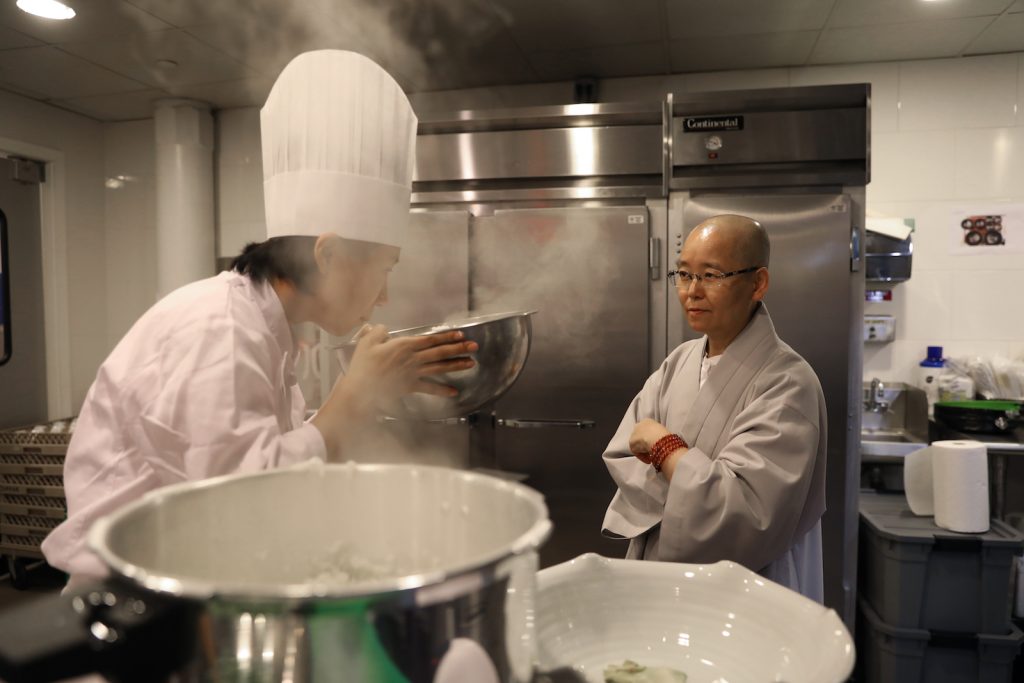What can decades-old fermented sauce, soybean paste, and ginger grain syrup tell us about Buddhist teachings on nonattachment, mental discipline, interdependence, and gratitude? As it turns out, a whole lot.
These ABCs of Korean ingredients were used to flavor dishes served during this year’s Korean Cultural Week, held from September 26–28 in New York City. The event, now in its fifth iteration, gave New Yorkers an insightful glimpse into South Korea’s culinary arts and rich Buddhist history.
Crafting the program’s menu was Beop Song, a Korean Buddhist nun and internationally acclaimed chef, though she winces at the latter title. But don’t let her pearl grey robes deceive you—Song can command a kitchen on a par with any top chef. (It may have something to do with the 20 years of meditation practice she has under her belt.)
Although temple food has a reputation for being tasteless and unimaginative, more than 55,000 foreigners flock to South Korea’s remote mountain temples every year to experience monastic life and dining, according to the Cultural Corps of Korean Buddhism.
Below, Song, a cookbook author, food columnist, and culinary instructor who splits her time between Yeongseonsa Temple in the foothills of Daejeon City, South Korea, and traveling the world, explains why the Korean Buddhist diet is so appealing to the Western palate. Behind the scenes at Korean Cultural Week, Tricycle spoke with Song through a translator to hear how the ancient art of Korean temple food can nourish our minds and bodies—and clean up our eating habits.
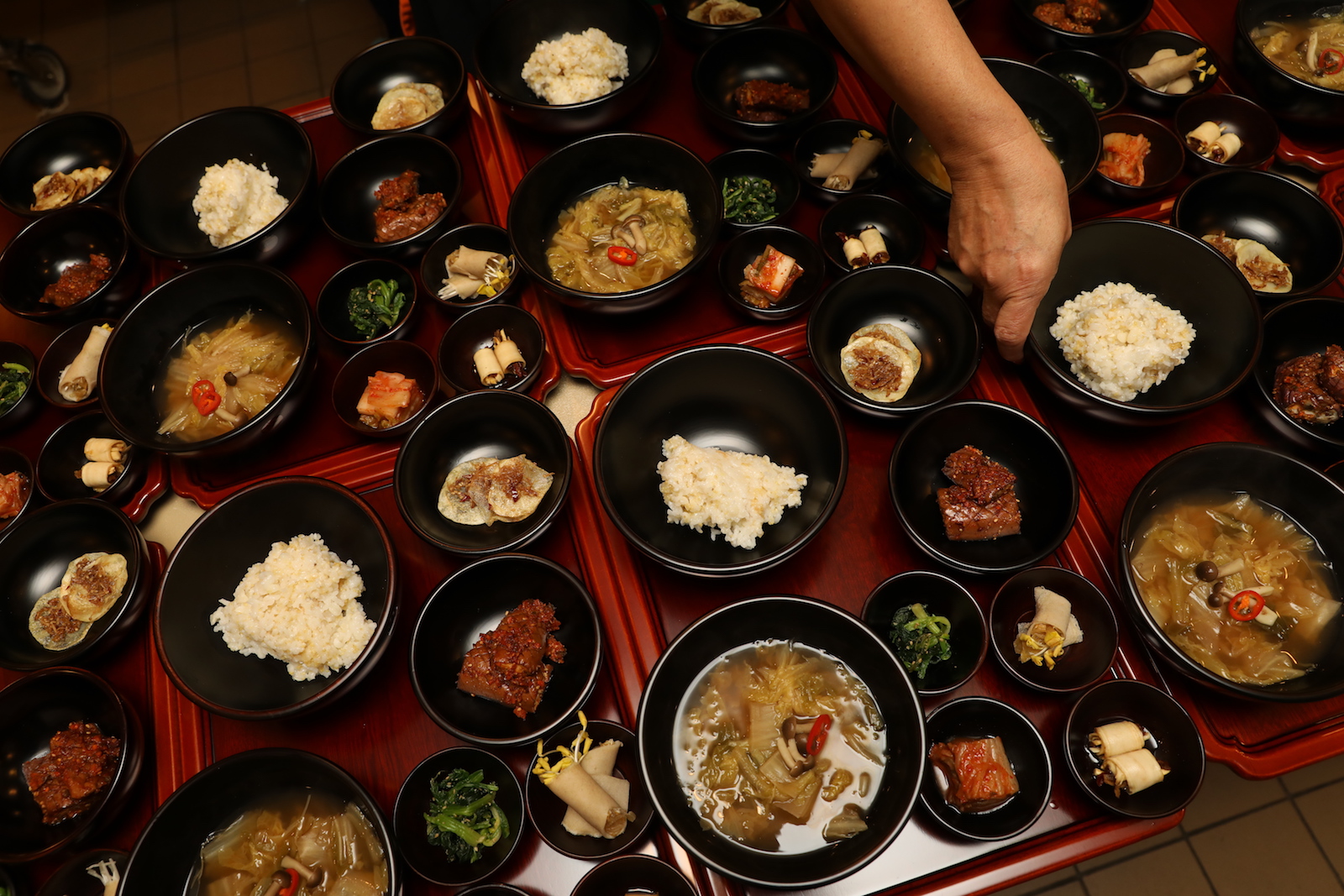
How did you discover your love for cooking? When I first started out as a Buddhist nun, I couldn’t really do much else outside the temple walls. During my first three years, the only thing I could do was go into the kitchen to watch others prepare food and help clean the dishes. Sometimes I would go into the backyard to wash lettuce and cook rice.
I spent the following four years studying Buddhist teachings more intensively. It was within that period that we had an opportunity to cook for other monks and nuns. I realized then how much I enjoyed it. The food I make today is the food I learned from watching my teachers and senior monks. Nowadays when I train young nuns in temple cooking I emphasize learning by doing.
It’s been over 20 years since you became a nun. What drew you to monastic life? I grew up in Uljin, a very small remote town in the mountains. It was a real no-man’s land and lacked a central temple. There was a monastery in a neighboring town, and I remember holding my grandmother’s hand, walking with her whenever she would go. Long before I became a nun I read Be As You Are, a collection of teachings by Sri Ramana Maharshi, and realized there was a completely different world out there that valued non-possession.
I’d like to share with you a verse from a song written by Naong Hyegeun, a 14th-century Seon Master [Seon is the Korean variant of Chan Buddhism]:
The green mountain asks me to live in silence
The blue sky asks me to live without dust
Letting go of anger and letting go of greed
They ask me to live and go away
Just like the stream and like the wind
To live like flowing water, like wind—this is why I shaved my head and put on these robes.
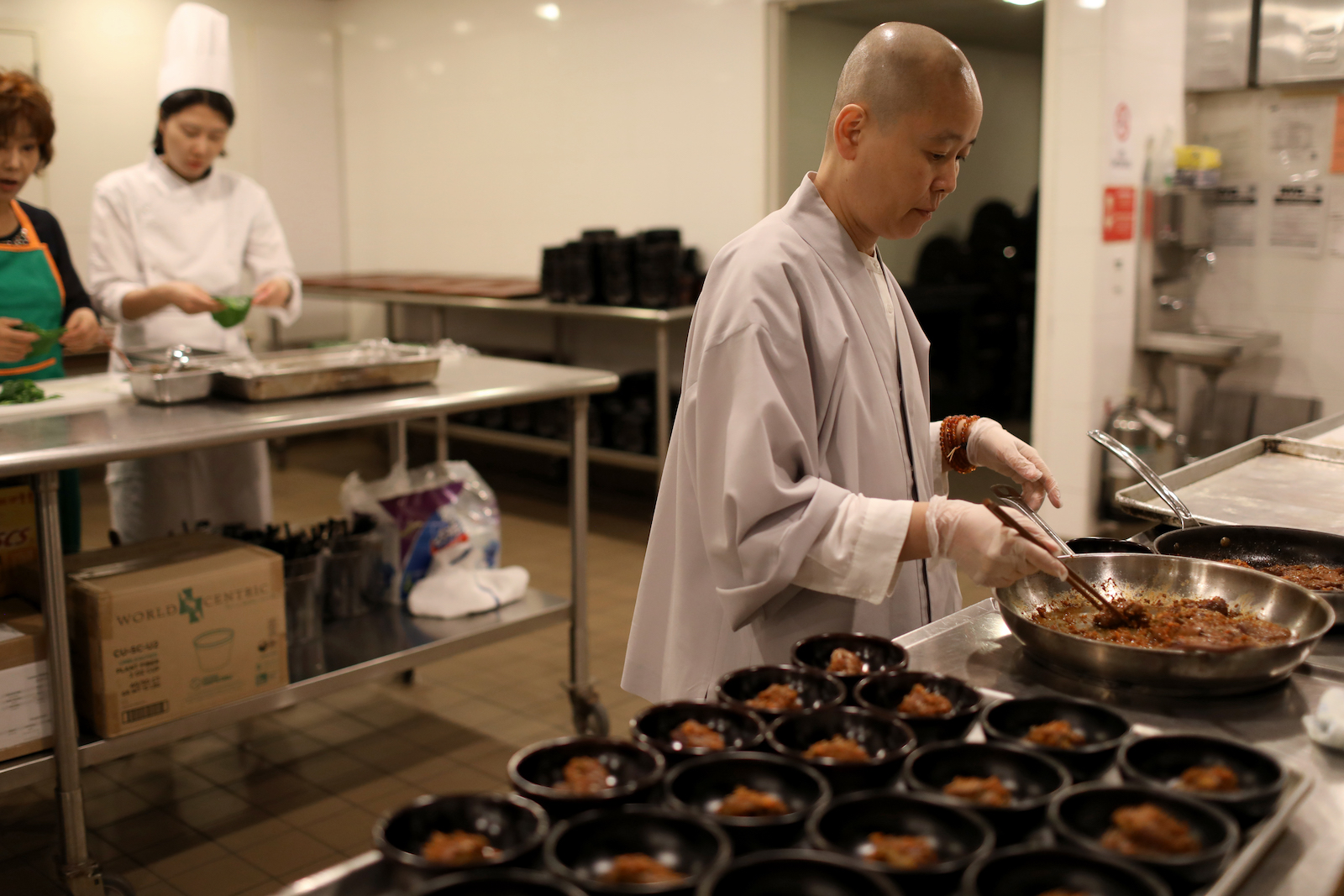
It seems like you are straddling two very different vocations. How have these two practices—the spiritual and culinary—informed one another? The eyes feed you by seeing, the nose by smelling, the ears by hearing, touch by feeling, and the mind by thinking. Everything in your body is doing its part to feed you. To meditate, work, and do just about anything, you have to eat, which is why food is very important for most people.
The words for Buddhist monk and nun are bhikkhu and bhikkhuni, which translate as “one who receives food” or “beggar.” In the larger Buddhist picture—and especially for monastics—food is a lesser concern. It allows us to survive so we can continue meditating. Its purpose is to sustain us.
For me, temple cooking is an exercise in gratitude and goes hand-in-hand with prayer. We make a lot of rice cakes in temples across Korea and always pour prayers into the food. Sometimes I’ll concentrate solely on studying, meditating, and strengthening my devotion. Other times, I’ll return to the kitchen. It is through cooking—something I deeply care about—that I’m able to introduce others to Buddhism. As temple food spreads globally, it has become a larger priority of mine, but when I’m at my temple eating and cooking with other nuns, it’s only a small part of my life. This is why I don’t consider myself a chef—I prefer to see myself as a Buddhist nun-in-training.
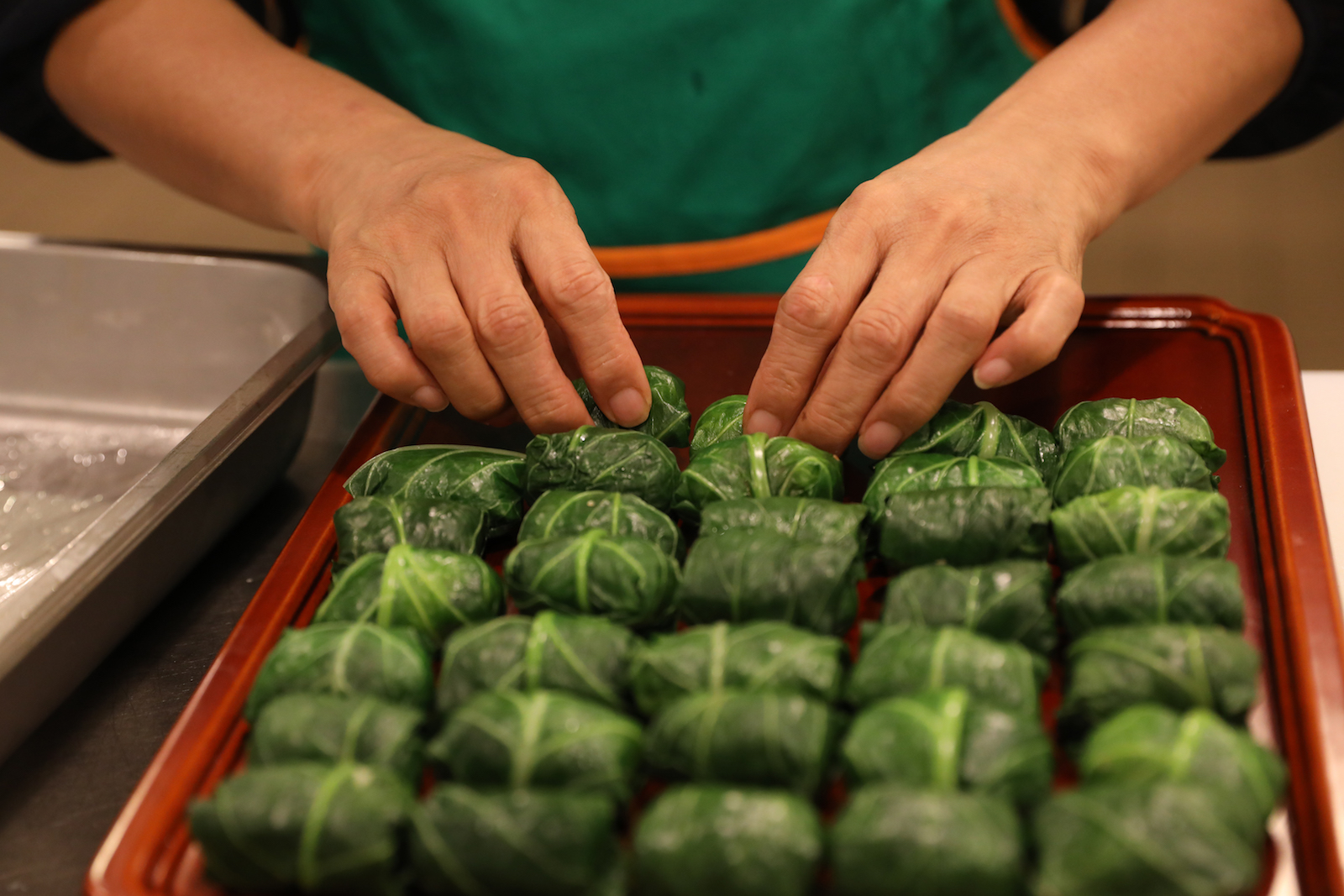
There are many fad diets that come and go, but the Buddhist diet, like the religion itself, has been popular in Korea for 1,700 years. It seems like today’s chefs, foodies, and a handful of scholars are starting to take note. Why the sudden wave in interest? The temple diet is mainly plant-based, with a focus on eating seasonal, locally grown foods. One reason could simply be that there are a growing number of vegans and vegetarians today who value these things. Although temple food has always existed in Korea, it hasn’t taken center stage because Koreans really love their meat and fish.
What can aspiring or well-established chefs, as well as those of us who dabble in the kitchen from time-to-time, learn from Korean Buddhist principles and traditional cooking methods? When monks and nuns first learn how to cook, they are taught to abide by three guidelines. The first is cleanliness. Your environment, ingredients, and most important, your mind, should all be clean. Once, I got scolded by a teacher of mine and went into the backyard to kick something a couple of times before returning to the kitchen. My teacher refused to eat the food I prepared because it had been poisoned by my anger.
The second guideline involves flexibility, moderation, and harmony. There are five pungent vegetables that are forbidden in temple cooking: scallion, garlic, chive, wild garlic, and onion. These five ingredients can change the taste of an entire dish. It is believed that when cooked, these components inspire lust, and when raw, incite anger. Monks should always be cautious and avoid foods that are stimulating. In Buddhism, anger and greed are considered part of food. You can choose whether or not you consume them.
Harmony comes from balancing six fundamental flavors: spicy, sweet, salty, sour, bitter, and bland. I like to think about whether the meals I’m preparing will help practitioners meditate, because that’s what monks are supposed to be doing in temples, right? You should try to keep those who will be eating your food in mind when you’re cooking.
Once, I got scolded by a teacher of mine and went into the backyard to kick something a couple of times before returning to the kitchen. My teacher refused to eat the food I prepared because it had been poisoned by my anger.
Last, you should follow the natural order. You shouldn’t have to force anything to taste good. I was taught that only when you cook with your whole mind will the food’s natural flavor come out.
Your recipes and cooking style are incredibly inventive. When it comes to food, how important is creativity and personal expression?
There are certain foods that Koreans never get bored of: doenjang [fermented soybean paste] and bap [cooked rice] for starters. If you cook in the same way every day, people get bored. Eating the same foods over and over is tiring, too. If you give the same eggplant to a group of people, they’ll all come back with different dishes. The outcome will always change a little bit—it’s human nature. Since we have limited ingredients to work with, creativity is a natural part of everyday temple cooking.
At its heart, your philosophy of food is about transformation. During last week’s cooking demonstration, you showed us how to create something entirely new from ordinary, everyday ingredients.
One of my favorite dishes to make is gamja-gui, or pan-fried potato slices topped with a Korean red date (jujube) and chestnut garnish. This dish is not so much a recipe as it is something I learned by watching one of my teachers. Red dates and fresh chestnuts are commonly used in temple cooking and happen to be celebratory ingredients in Korea. They signify bountiful harvests and prosperity for families, which is why they often appear in wedding ceremonies.
At the end of February, we remove and shave the sprouts from the potatoes we’ve stored over the winter. Then, we plant them to grow a new harvest. We peel and slice the leftovers to make this dish. In our temples, we try not to waste a single drop of water or grain of rice. At the end of the day, it may look like a fancy presentation, but I’m cooking with one of the most universal ingredients. By dressing potatoes up with soy sauce, grain syrup, and all of these traditional Korean flavors, you get a unique, nutritious dish out of something that others would usually throw away.
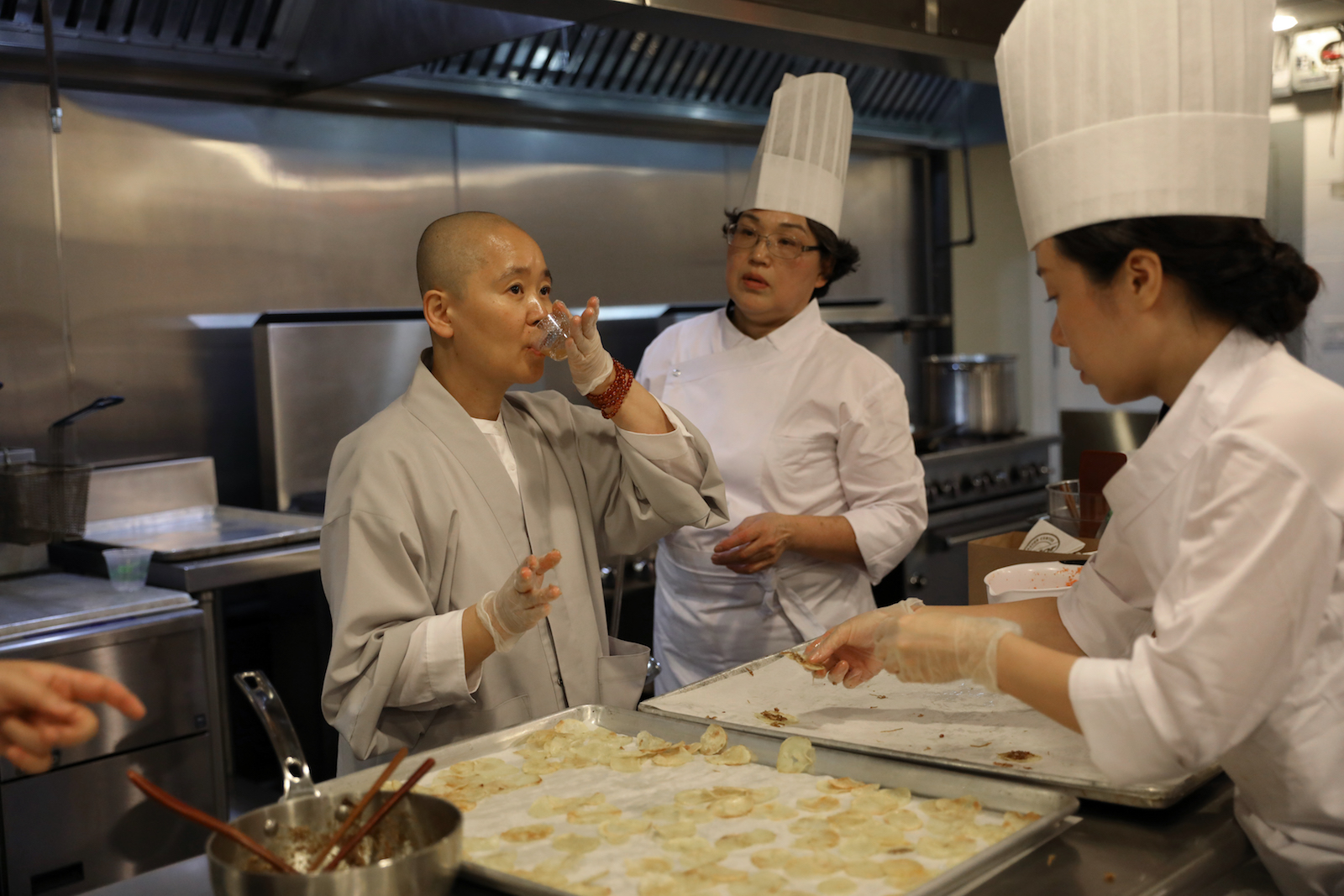
You’ve likely heard the popular saying you are what you eat. Buddhists might amend this to you are how you eat. How do our eating habits relate to the quality of our minds? Food—and the way we eat it—can be medicinal or poisonous for spiritual progress. Oftentimes, people worry too much about what they’re eating. Going back-and-forth worrying about whether to eat something is worse than actually just eating what you are given. What’s more important than what you eat is when and how much you’re eating. Whatever you’re consuming, if you’re eating lots of it, it can be hard to concentrate afterwards. Monks eat in small amounts and tend to satiate only 70 percent of their hunger. Even to this day, they will stop eating after noon to maintain a clear mind. Reducing the amount you consume and not eating to your heart’s content are two things anyone can incorporate into their lives.
Today, it is becoming more and more popular to eat late at night. There’s a saying in Korea: mealtime for the gods spans from 3 a.m. to 5 a.m.; humans eat from 9 a.m. to 12 p.m; animals eat in the evening around 5 p.m.; and ghosts eat after 9 p.m.
That definitely makes me a hungry ghost. [Laughs.] Not me, I go to bed at 9 in the evening and wake up at half past 3 to chant my morning prayers!
|
Gamja-gui (Pan-fried potato) Many Korean dishes, especially temple dishes, can be prepared easily and quickly with simple ingredients at home. Makes 4 side servings. Ingredients: Barley Syrup Sauce Instructions:
|
Learn about the guiding values, principles, and history of traditional Korean temple cuisine through quick, easy, and delicious recipes in “Korean Buddhist Cooking,” our new four-week Tricycle Online Course set to run on April 23. To learn more and sign up, visit learn.tricycle.org.
Thank you for subscribing to Tricycle! As a nonprofit, we depend on readers like you to keep Buddhist teachings and practices widely available.
